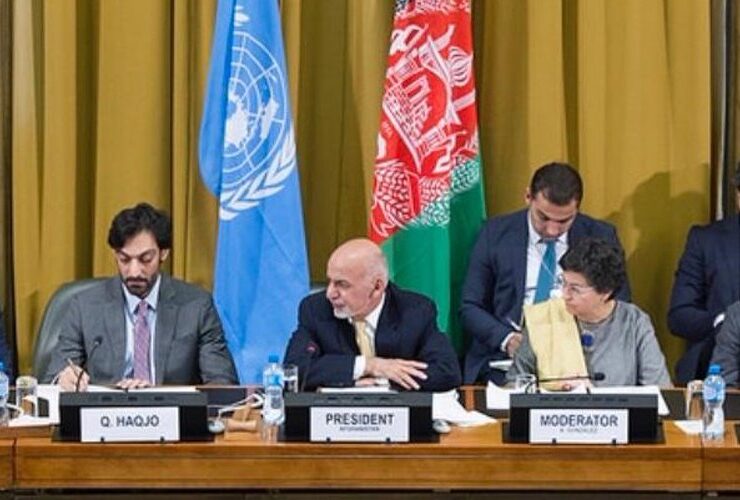Regional Connectivity

AFGHANISTAN’S SOLUTION FOR ITS ECONOMIC FUTURE
South and Central Asian economies are growing rapidly. The World Bank forecasts the overall average economic growth rate for South Asian countries at 7.1 percent in 2018, creating a thirst for regional economic cooperation between Central and South Asian (CSA) countries, particularly as related to supply of energy. In these emerging CSA markets, India enjoys the strongest economic growth at around 7.2 percent in 2018. Pakistan has been on a gradual economic recovery projected at an average rate of 5.5 percent in 2018, characterized by a decreasing inflation rate, fiscal consolidation, and plans to rebuild its global economic position. China is set to invest $62 billion in the China-Pakistan Economic Corridor (CPEC), which will link Kashgar in the far northwest of China to Gwadar in the far southeast of Pakistan. Likewise, India has made significant investment in Iran’s Chahbahar, which only recently became operational.
The bulk of these countries are seizing opportunities to complete massive regional energy connectivity projects. Some of these include:
- The Five Nations Railway (FNRC) Corridor, connecting China to Iran via Afghanistan, Tajikistan, and Kyrgyzstan.
- The Central Asia-South Asia (known as CASA-1000), transmitting surplus electricity from the Kyrgyz Republic and Tajikistan to Afghanistan and Pakistan.
- TUTAP, connecting Turkmenistan, Uzbekistan, Tajikistan, Pakistan, and Afghanistan, via electricity transmission lines.
- CASAREM, the Central Asia-South Asia Regional Electricity Market, whereby Afghanistan could effectively operate under the connectivity strictures of not only the FNRC, CASA-1000, and TUTAP, and TAPI, but many other connectivity initiatives on the horizon.
- Turkmenistan, Afghanistan, Pakistan, India (TAPI) pipeline, supplying natural gas from the Central Asian country to the South Asian ones.
Of these, TAPI, aka the “Trans-Afghanistan Pipeline” holds the strongest promise for Afghan connectivity and its future! As it was mentioned in a recent article by Jelani Farhad, spokesman for the Herat provincial governor’s office, realizing TAPI’s promise of a “golden day” for Afghanistan requires the most adroit solutions because despite the turbulent times, significant geo-economic shifts are occurring in Afghanistan and it’s best positioned to CSA countries. If the right solutions with respect to TAPI are addressed and taken, Afghanistan could sit much more stable in its potential as the gateway to its own vast northern regions of oil and gas reserves, as well as those of wider Central Asia. In the best case, Afghanistan could finally win its chance to bask far more golden than it does now.
Just visualizing these connectivity initiatives has created an environment much more apt to stir economic cooperation between the two CSA markets, via energy projects bound to increase GDPs of all Central Asian countries. This has driven both the potential and the reality of more reliable income streams for Afghanistan, radiating from the associated duties and transit fees levied on the roads, railways, pipelines, and electric transmission lines that a new regional project would require.
Indeed, a recent United Nations report estimated that within a decade, these regional trade projects coupled with the creation of new energy transmission markets, bolstered by the necessary construction of transnational infrastructure, will increase the GDP of Afghanistan by 50 percent. On the ground, this translates into more reliable employment, hotter job markets, and the creation of new energy and construction-related business enterprises — factors that will further increase Afghanistan’s annual GDP growth, while also providing increased stability. It’s hard to ignore the recent inauguration of Afghanistan portion of TAPI gas pipeline, with its capacity to carry 33 billion cubic meters (43 billion cubic yards) of natural gas from Turkmenistan to Pakistan and India through Afghanistan’s Herat, Farah, Helmand and Nimroz provinces as a major potential solution to Afghanistan’s current stability and future prospects.

Afghanistan’s potential key role as an energy connector among all the CSA countries is heavily dependent on its relationship with its neighbors, which is why divining the right solutions toward establishing itself as a regional connector is so vital. To this end, Afghanistan must ensure:
- Internal cooperation between its many tribal, governmental, and religious stakeholders, who all must agree that any new Afghan connectivity, especially its rich energy potential, must benefit everyone. Afghan President Ashraf Ghani told those gathered at the TAPI inaugural that the pipeline is a message to future generations, proclaiming, “Our message is one of cooperation throughout our region.” Speaking about infrastructure development, Ghani went on to say that the next big project being prepared is the laying of Afghanistan’s first railway tracks from the Turkmenistan border to Iran.
- External cooperation among the governments of wider South and Central Asia, especially historically hostile neighbors India and Pakistan, and contentious neighbors Pakistan and Afghanistan. These countries must be encouraged and incentivized to cooperate toward spreading awareness of the utility and benefits of these important new sector linkages, which might also serve as a coolant to the more combustible political constraints they all face. Meeting external cooperative success will require a careful sequencing of key energy development measures over time and across stakeholders, in order to maximize the impact of the projects and maintain a steady progress for all involved. The TAPI pipeline project has, so far, shown that such regional cooperation is possible, as highlighted by Pakistan’s Prime Minister Shahid Khaqan Abbasi attending the TAPI ribbon cutting along with a representative of the Indian government. To seal this external cooperation, Afghanistan must also send its regional partners the strong, unified message that it is able to internally align all its stakeholders, supporting realization and stewardship of these projects.
- Adequate security measures, perhaps the most important challenge to be solved, especially given Afghanistan’s fraught security situation and devastated physical infrastructure. Security remains a prominent obstacle to these regional projects, primarily because TAPI, and the other assertive projects, are planned to pass through insecure areas with poor infrastructure. For Afghanistan to secure, for itself and others, the 744-kilometer natural gas pipeline, Kabul needs to demonstrate sustained improvement in its security and infrastructure, key factors that will serve as either catalysts or deal breakers for any future regional development projects beyond TAPI.
Solving the puzzle of how to achieve successful and secure connectivity via Afghanistan’s transnational links with respect to TAPI among South and Central Asia, would certainly revive the country’s historical and natural hub position in the region. The sooner this happens, the better prospects for the country. Perhaps even the Taliban will practically see the light of Afghanistan’s potential golden day.







